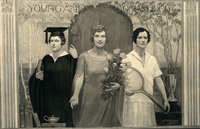Decorative Details and Character
The architects of the Michigan Union and Michigan League encoded their buildings with ornamental motifs, portraits, relief sculptures, and even color patterns to represent the development of the individual.
[1] On the facade of the Union's main State Street entrance, the athlete and the academic are on prominent view as relief sculptures. Above the west entrance to the League are female figures representing friendship and character.
Throughout the interiors of both buildings, a cube appears in wood, stone, and metal, with and without color. This ornament was intended to illustrate the architects' idea of the individual gaining poise, strength, and perfect character.
[2] Additional aspirational images appear in the form of J.E. McBurney's original murals for the League. McBurney chose to depict great women from history - including Spanish and English Queens Isabella and Elizabeth I, Ancient Greek intellectuals Sappho and Aspasia, and Mughal monarch Mumtaz Mahal - before alluding to the League's intended users in Young American Womanhood. The last is still on view in the Hussey Room in the League.
Both the Union and League were designed for gatherings of large groups of students. The original architectural drawings by Pond and Pond illustrate how meeting rooms, dining halls, and large assembly rooms for formal dances were programmed into both buildings. Among the differences: the League was to include a chapel for meditation and a theater while the Union was planned for more active pursuits such as billiards and swimming. Although the two buildings' overall appearances are quite similar, they were created with explicit distinctions for male and female occupancies. The architects stated that:
Every man's Union has to be planned to accommodate women; and every women's League must be planned in reference to the accommodation of men. In a man's building the very minimum of accommodation for women may quite properly be provided; while in a woman's building the maximum of accommodations must be provided for men. For men will gather in clubs and enjoy themselves without the presence of women, while women, especially college girls, find their enjoyment greatly enhanced by the presence of men or boys. [3]
The below photographs and drawings illustrate some of the active and contemplative uses for which the Union and League, respectively, were designed.
[1] Irving K. Pond, The Autobiography of Irving K. Pond: The Sons of Mary and Elihu, eds. David Swan and Terry Tatum (Oak Park, Illinois: Hyoogen Press, 2009), 291-292.
[2] Irving K. Pond, Autobiography, 292.
[3] Irving K. Pond, "The College Union," reprinted from the Architectural Forum (New York: 1931), 771.









